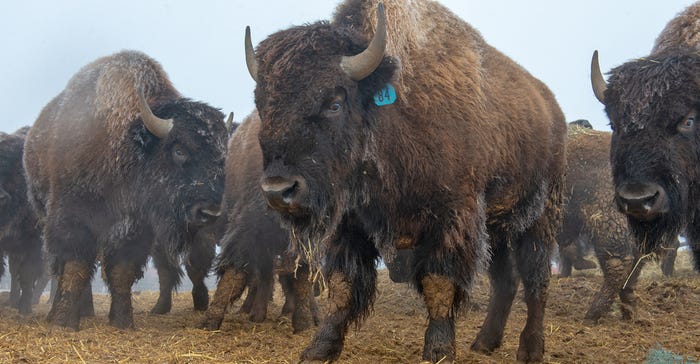March 6, 2019

By Luann Dart
Indian Springs Bison owner Roy Krivoruchka and his family have raised bison near Belfield, N.D., for the past 25 years. Most of the shaggy beasts are penned in the ranch’s feedlot, where Krivoruchka feeds the heifers to 1,000 to 1,100 pounds and the bulls to 1,200 to 1,300 pounds. He then markets the heads, hides and meat from the bison.
About 60 animals are slaughtered directly from the ranch, while the rest are shipped to the Western Buffalo Co., Rapid City, S.D., or to Rocky Mountain Natural Meats, Bush, Colo.
Krivoruchka purchases an entire herd’s weaned bison calves weighing about 400 pounds, then sorts them according to size, also splitting the bulls and heifers.
“Our feedlot was designed for 500 head,” he says. “We like to maintain that 400 to 500 head year-round.” He feeds the bison for about 12 months before selling for slaughter.
Krivoruchka also raises 150 commercial Angus and Angus/Hereford cross beef cattle and has about 50 buffalo cows. He appreciates the differences between bison and cattle.
Benefits of bison
With a full-time job off the ranch, he found bison required less maintenance than beef cattle, due to calving ease and fewer health issues.
“We tried the buffalo side and we enjoyed it, so we just expanded into it. It’s less demanding,” he says. “We don’t have the calving issues and we don’t have a lot of issues in the feedlot.”
In the feedlot, Krivoruchka’s bison are fed buffet-style, with free choice of hay and corn-based pellets in creep feeders. When the bison reach 800 pounds, their forage quality is decreased so they consume more grain.
“If you give them grass, they’ll eat the grass, because that’s their nature. So, we cut them back on their good hay supply and move them to a rougher forage so they eat their grain,” he says.
“I’m not the typical feedlot bison feeder, because I don’t treat them like Mother Nature,” he says, explaining that he pushes the bison to reach goal weight.
“My theory is time is money, so we treat them like a beef cow,” he says. “If we can kick them out in 12 months versus 14 months, that’s two months of feed we didn’t pay for.”
“We run a very efficient feedlot,” Krivoruchka says. Bison don’t require high-protein feed, so he feeds 14% protein or less. About 10 years ago, he formulated his own pellet ration and has used it since. Feed and other costs average about $400 a year per animal.
“Our death loss is less than 1%. We have no overeating issues. They are on their own, with very little maintenance,” he says. “They’re hardy, they’re tough. The cold or snow doesn’t affect them.”
Calves are vaccinated when they are weaned at their home ranch, and Krivoruchka deworms the animals once through their feed in the spring.
Otherwise, the bison are only handled as they pass through the scales. Those that are at the goal weight are marketed, while anything under that weight is kept longer.
At the slaughter facilities, the bison are graded, and their teeth are checked for age. Krivoruchka receives a premium for his bison meat due to the marbling and fat covering on the ribeye, he says.
The bison are contained in the feedlot with pipe and sucker rod welded into a 7-foot-tall structure. Handling facilities are made of the same material, with conveyor belt material covering the fencing.
“If they can’t see through it, they won’t try to run through it. If it’s above their eye, they won’t jump it,” Krivoruchka says.
Growing the operation
When the ranch expanded the feedlot 18 years ago, the family turned to the Natural Resources Conservation Service in Billings County, N.D., to provide both expertise and cost-share assistance to the ranch to construct a wastewater management system that is certified by the North Dakota Department of Health.
“We were concerned with the wastewater going into the Green River and they could see the cheapest, simplest route for a producer to use,” Krivoruchka says.
The feedlot is located on a hillside along a shelterbelt, so a diversion dike was constructed along the shelterbelt that moves the snowmelt water away from the feedlot and into a nearby creek.
Wastewater from the feedlot follows a gradual downhill slope into a natural drainage where an embankment was installed to form a holding area, preventing wastewater from entering the Green River.
Krivoruchka is glad he started the feedlot operation.
With a foundation of consumer demand, bison burgers and steaks are now common menu items at mid-level restaurants and buffalo ranchers are experiencing a stable market, although it has dipped recently.
“The calf prices are probably $400 a head less than a year ago, but they’re still spendy,” he says. Last year, calves cost $1,800 to $2,000 each, while they most recently sold for $1,400 to $1,600. The meat market came down 60 cents a pound and is now in the $4.10 to $4.50 range.
To vertically integrate, Krivoruchka is planning to build a state-inspected meat processing facility on his ranch. His son attended college in Olds, Alberta, Canada, and graduated as a professional meat cutter. The family hopes to open the doors to the facility in the fall of 2019.
“We want to do our own brand of meat,” Krivoruchka says, but they also plan to do slaughtering for others, with a goal of processing seven to 10 animals a week.
“We don’t have that in southwestern North Dakota,” he says. “There are less meat cutters than there were five years ago.”
With that investment, Krivoruchka intends to remain in the bison business.
“It’s been very rewarding for us the whole time we’ve been in it,” he says.
Dart writes from Elgin, N.D.
You May Also Like




